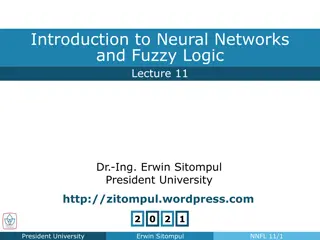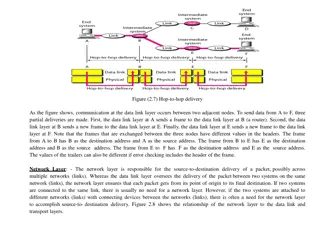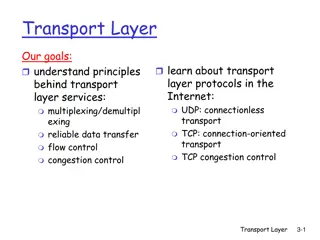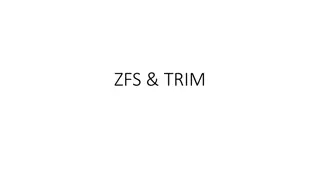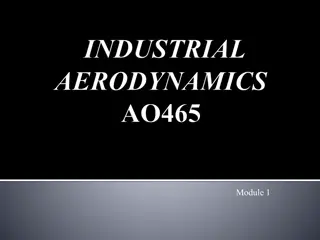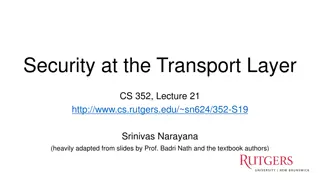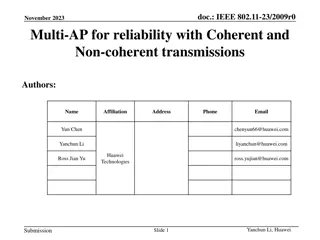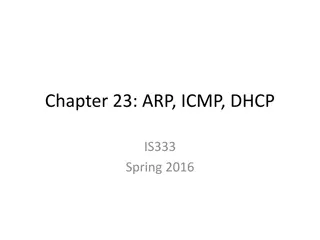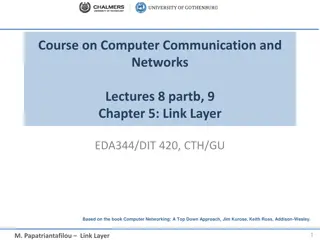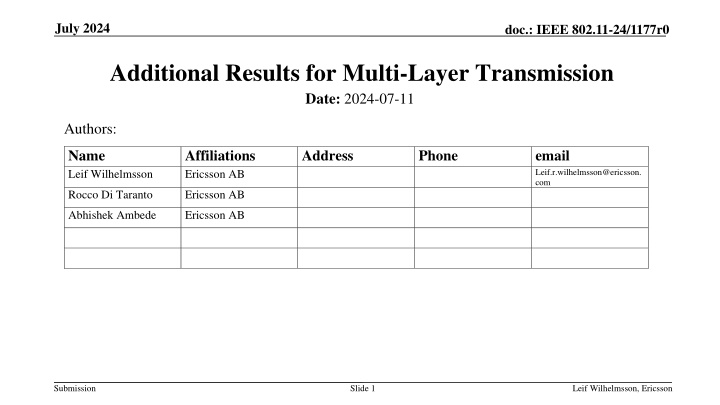
Achieving High Reliability in Multi-Layer Transmission for IEEE 802.11-24
Explore the challenges and motivations behind achieving ultra-high reliability with low latency in multi-layer transmission according to IEEE 802.11-24 standards. Learn about the importance of reliability in cutting-edge applications and the trade-offs between reliability and data rate for mission-critical scenarios.
Download Presentation

Please find below an Image/Link to download the presentation.
The content on the website is provided AS IS for your information and personal use only. It may not be sold, licensed, or shared on other websites without obtaining consent from the author. If you encounter any issues during the download, it is possible that the publisher has removed the file from their server.
You are allowed to download the files provided on this website for personal or commercial use, subject to the condition that they are used lawfully. All files are the property of their respective owners.
The content on the website is provided AS IS for your information and personal use only. It may not be sold, licensed, or shared on other websites without obtaining consent from the author.
E N D
Presentation Transcript
July 2024 doc.: IEEE 802.11-24/1177r0 Additional Results for Multi-Layer Transmission Date: 2024-07-11 Authors: Name Leif Wilhelmsson Affiliations Ericsson AB Address Phone email Leif.r.wilhelmsson@ericsson. com Rocco Di Taranto Ericsson AB Abhishek Ambede Ericsson AB Submission Slide 1 Leif Wilhelmsson, Ericsson
July 2024 doc.: IEEE 802.11-24/1177r0 Outline Brief recap of the Multi-Layer idea, motivation and principle Additional simulations for various MCSs Conclusions Submission Slide 2 Leif Wilhelmsson, Ericsson
July 2024 doc.: IEEE 802.11-24/1177r0 Motivation Although an increase in maximum data rate may be nice, what is believed to be more important is if a significant improvement in reliability could be achieved The name UHR suggests high reliability would be high on the agenda and the PAR [1] states Cutting-edge applications offer a wide range of digitally enhanced worlds, realities, and business models that have the potential to revolutionize both personal and enterprise activities in the next decade. These applications require large throughput combined with reduced and predictable worst- case delay and jitter, high reliability, and improved power efficiency. The reduced and predictable delay is partially addressed by improved channel access mechanisms, e.g., preemption. However, it typically (implicitly) assumes reliability since if one or more retransmissions are needed, the delay may neither be reduced nor be predictable Submission Slide 3 Leif Wilhelmsson, Ericsson
July 2024 doc.: IEEE 802.11-24/1177r0 Challenges related to achieving high reliability Achieving Ultra High Reliability is typically not enough, the reliability must be achieved with low latency for the data to be useful Relying on retransmissions may not be attractive and may not even be an option for certain applications In 3GPP this is addressed by URLLC/HRLLC, targetingmission-critical applications such as factory automation, autonomous driving, and virtual/augmented reality UHR seems to pretty much target similar use-cases Operation in license-exempt bands adds yet another challenge In licensed bands, the main issue is channel variations (fading) faced by the desired signal In license-exempt bands, the major cause for receiver condition variations may instead be interference The obvious approach to get higher reliability is to reduce the MCS This is OK if the data comes relatively seldom, but for continuous data high reliability then results in that the spectrum efficiency becomes very low The trade-off between reliability and high data rate is of course not new Submission Slide 4 Leif Wilhelmsson, Ericsson
July 2024 doc.: IEEE 802.11-24/1177r0 Multi-layer transmission revisited Data Data Preamble Preamble OFDM Symbols OFDM Symbols 1 0 0 0 1 0 0 0 1 1 0 1 1 1 0 1 The idea is to send a number of codewords in parallel, with different robustness, and decode as many as the channel conditions allow for [2] Compared to the standard single layer approach, several layers with different reliabilities are used Submission Slide 5 Leif Wilhelmsson, Ericsson
July 2024 doc.: IEEE 802.11-24/1177r0 Multi-layer transmission revisited M = 256, Rate = 1/2 In [3], the gains by using multi-layer transmission and/or HARQ were considered by means of system level simulations Multi-layer transmission was found more effective than HARQ, and if combined even better performance was obtained Submission Slide 6 Leif Wilhelmsson, Ericsson
July 2024 doc.: IEEE 802.11-24/1177r0 Numerical results: Assumptions In [4], the simulation results were only for the (1944, 972) LDPC code Here the corresponding simulations are shown for MCS5-MCS13 To more easily appreciate the basic idea, the simulations are deliberately done for simple conditions AWGN channel Perfect channel knowledge at the receiver, no frequency offset, etc. No interleaving included The results are consistent with what was presented in [4] Layer 1 uses one of the most reliable bits in the constellation map for a given modulation Layer 2 uses the remaining bits The larger the modulation order, the larger the difference in robustness for the layers Submission Slide 7 Leif Wilhelmsson, Ericsson
July 2024 doc.: IEEE 802.11-24/1177r0 Multi-layer transmission for high reliability [4] Now, suppose the goal is to replace (enhance) the single layer transmission with a two-layer transmission with the same total data rate, but which has one layer with significantly improved reliability The natural choice to achieve this is as follows: Layer 1 uses only bit 1 Layer 2 uses bits 2+3+4+5+6+7+8 The result is: An increased robustness of roughly 10 dB for Layer 1 A loss of less than 1 dB for Layer 2 Submission Slide 8 Leif Wilhelmsson, Ericsson
July 2024 doc.: IEEE 802.11-24/1177r0 For the same code rate (3/4), the performance for layer 1 is largely independent of the modulation Submission Slide 9 Leif Wilhelmsson, Ericsson
July 2024 doc.: IEEE 802.11-24/1177r0 Performance for r = 5/6 Submission Slide 10 Leif Wilhelmsson, Ericsson
July 2024 doc.: IEEE 802.11-24/1177r0 Conclusions It is expected that some highly relevant use cases for UHR would benefit from (or even require) some of the bits to be delivered with high reliability and low latency An approach for achieving this is proposed, where the overall data rate is kept the same and the performance loss for the remaining bits is small The approach can be implemented with a single encoder/decoder, with proper buffering Submission Slide 11 Leif Wilhelmsson, Ericsson
July 2024 doc.: IEEE 802.11-24/1177r0 Straw Poll 1 Do you believe IEEE 802.11bn should consider multi-layer transmission as described in this presentation as a means to enhance the reliability? Submission Slide 12 Leif Wilhelmsson, Ericsson
July 2024 doc.: IEEE 802.11-24/1177r0 References 1. https://mentor.ieee.org/802.11/dcn/23/11-23-1252-04-0uhr-802-11bn- revised-par.docx 2. https://mentor.ieee.org/802.11/dcn/19/11-19-1133-00-00be-some-results-on- harq-performance-in-dense-deployments.ppt 3. https://mentor.ieee.org/802.11/dcn/19/11-19-1858-01-00be-harq-system- level-simulation-results.pptx 4. https://mentor.ieee.org/802.11/dcn/24/11-24-0435-00-00bn-ideas-related- to-achieving-ultra-high-reliability.pptx Submission Slide 13 Leif Wilhelmsson, Ericsson


